Healthcare System and Regulatory : Question and Answer
VerifiedAdded on 2022/08/23
|14
|3055
|14
AI Summary
Contribute Materials
Your contribution can guide someone’s learning journey. Share your
documents today.
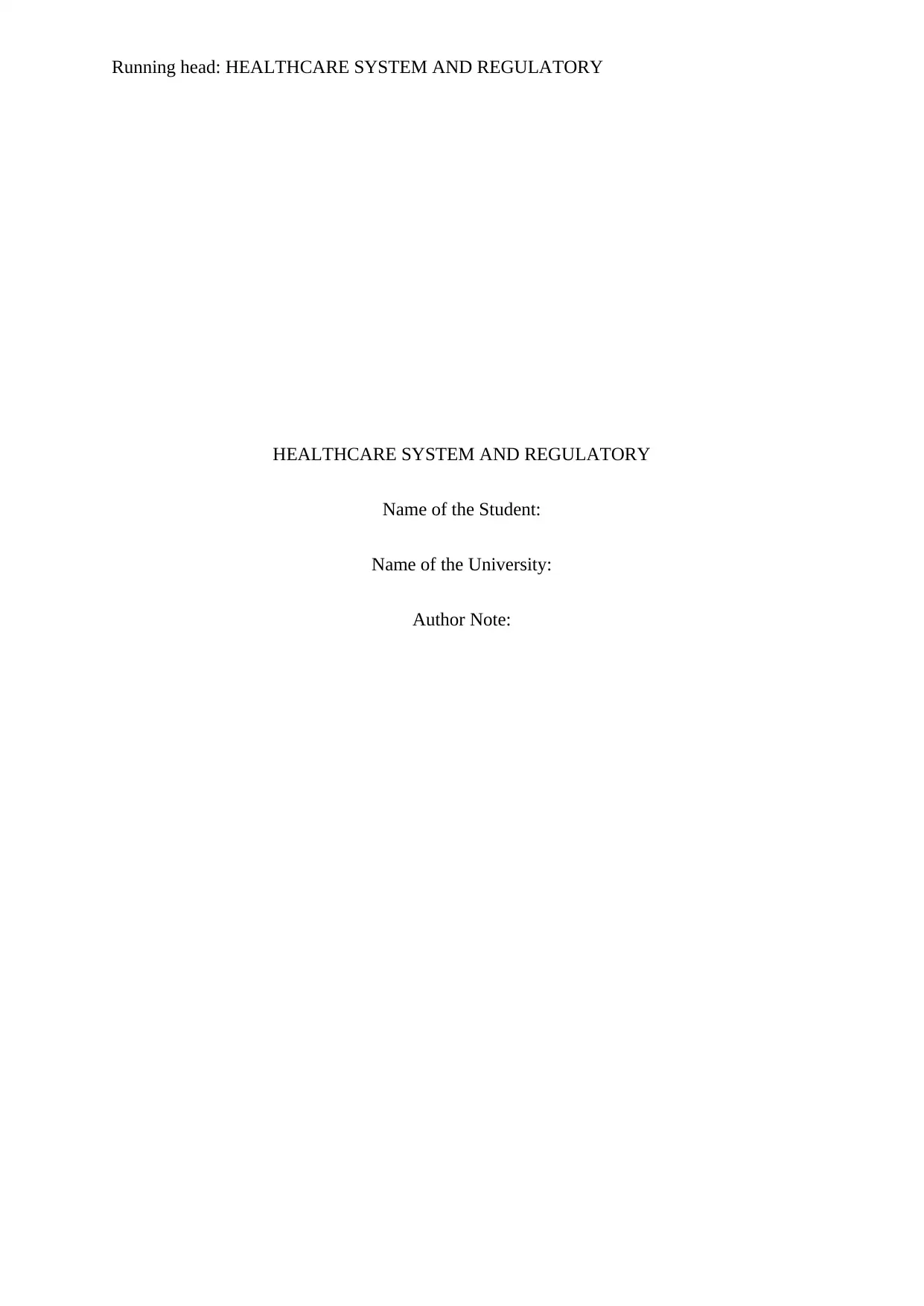
Running head: HEALTHCARE SYSTEM AND REGULATORY
HEALTHCARE SYSTEM AND REGULATORY
Name of the Student:
Name of the University:
Author Note:
HEALTHCARE SYSTEM AND REGULATORY
Name of the Student:
Name of the University:
Author Note:
Secure Best Marks with AI Grader
Need help grading? Try our AI Grader for instant feedback on your assignments.

1HEALTHCARE SYSTEM AND REGULATORY
Referring to Question 1
The traditional hospital delivers multiple services toward the patients. The services
include laboratory testing, intensive care, maternity, surgical services, advanced imaging,
radiology, and more. Patients feel comfortable to visit a hospital as they find multiple
disciplinary services in a single platform. However, pharmacies, home healthcare
organizations, and ambulatory surgical centers are beneficial in delivering specific care to the
patients. Patients visiting the hospital are prescribed with medications. Pharmacy plays a vital
role in providing drugs to the patients, along with explaining the procedures of intake of the
medication (Alexander et al. 2014). Patients have their freedom of choice in availing of their
medicines. The hospital provides multiple services internally; however, due to the lack of
stock or inventory and scarce resources, independent pharmacies play a critical role.
Home health organizations play a major role in delivering care, especially to the adult
populations. These home health organizations provide services such as nursing services and
other therapeutic services. They meet the federal government guidelines and provides
additional care to the patients (Mankowska, Meisel and Bierwirth 2014). Patients do not have
to visit the hospital, and elderly people find it difficult to visits hospitals for routine follow-up
or other health-related issues. The home health organization improves the quality of care as
compared to the hospital. Hospital is a place where every age group of people visits, and due
to the larger inflow of patients, there are chances of lower satisfaction or poor experience of
care by the older adults. The home health organization is competing with a hospital in
respecting, providing support on a daily basis, availing the support from skilled nursing at
home, provides an effective diet, help in medication management. Besides, home health
organization provides effective health outcomes as they focus on the individual instead of
entire groups. Moreover, the cost of a home healthcare organization is lesser comparing to
the traditional hospital.
Referring to Question 1
The traditional hospital delivers multiple services toward the patients. The services
include laboratory testing, intensive care, maternity, surgical services, advanced imaging,
radiology, and more. Patients feel comfortable to visit a hospital as they find multiple
disciplinary services in a single platform. However, pharmacies, home healthcare
organizations, and ambulatory surgical centers are beneficial in delivering specific care to the
patients. Patients visiting the hospital are prescribed with medications. Pharmacy plays a vital
role in providing drugs to the patients, along with explaining the procedures of intake of the
medication (Alexander et al. 2014). Patients have their freedom of choice in availing of their
medicines. The hospital provides multiple services internally; however, due to the lack of
stock or inventory and scarce resources, independent pharmacies play a critical role.
Home health organizations play a major role in delivering care, especially to the adult
populations. These home health organizations provide services such as nursing services and
other therapeutic services. They meet the federal government guidelines and provides
additional care to the patients (Mankowska, Meisel and Bierwirth 2014). Patients do not have
to visit the hospital, and elderly people find it difficult to visits hospitals for routine follow-up
or other health-related issues. The home health organization improves the quality of care as
compared to the hospital. Hospital is a place where every age group of people visits, and due
to the larger inflow of patients, there are chances of lower satisfaction or poor experience of
care by the older adults. The home health organization is competing with a hospital in
respecting, providing support on a daily basis, availing the support from skilled nursing at
home, provides an effective diet, help in medication management. Besides, home health
organization provides effective health outcomes as they focus on the individual instead of
entire groups. Moreover, the cost of a home healthcare organization is lesser comparing to
the traditional hospital.
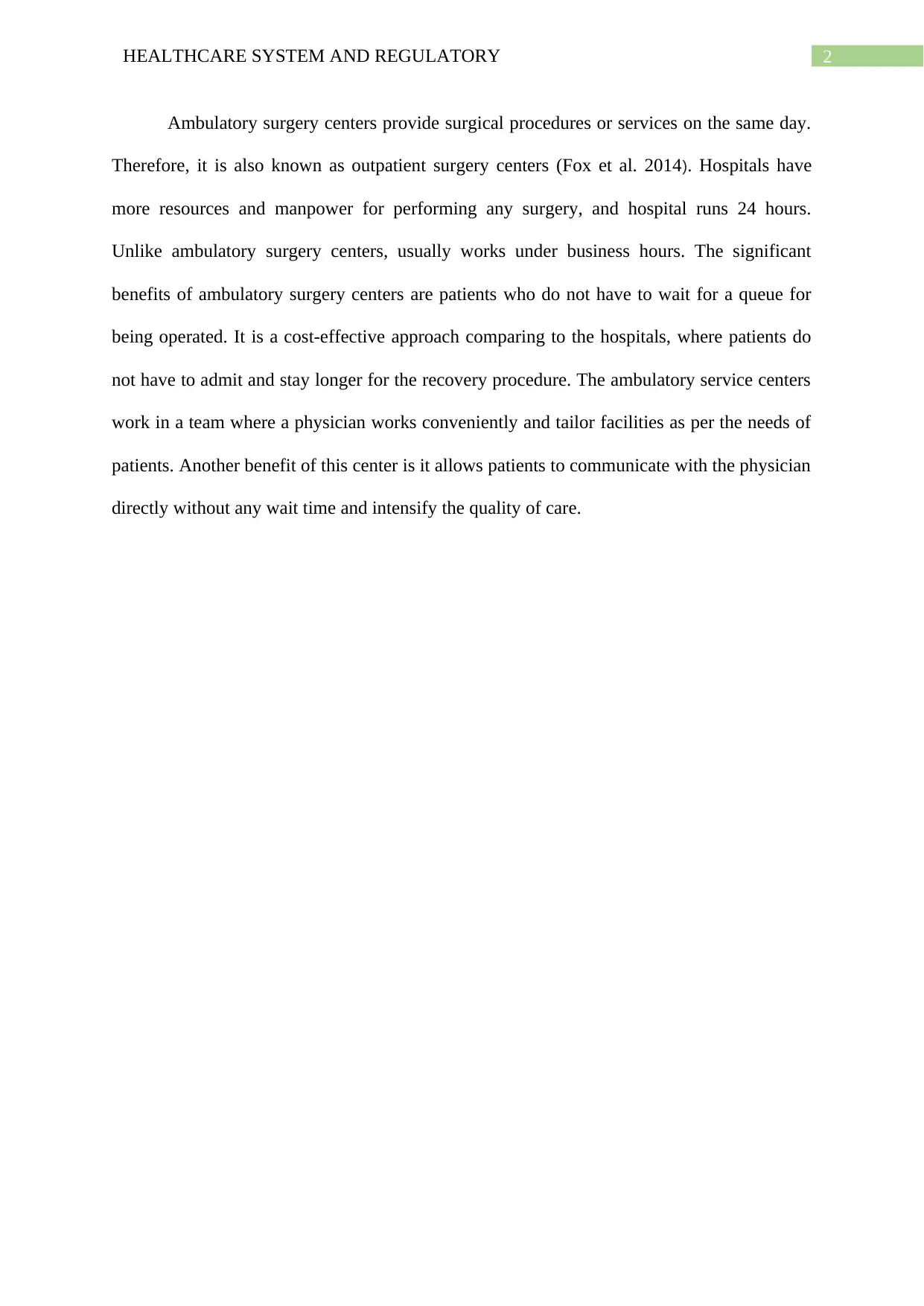
2HEALTHCARE SYSTEM AND REGULATORY
Ambulatory surgery centers provide surgical procedures or services on the same day.
Therefore, it is also known as outpatient surgery centers (Fox et al. 2014). Hospitals have
more resources and manpower for performing any surgery, and hospital runs 24 hours.
Unlike ambulatory surgery centers, usually works under business hours. The significant
benefits of ambulatory surgery centers are patients who do not have to wait for a queue for
being operated. It is a cost-effective approach comparing to the hospitals, where patients do
not have to admit and stay longer for the recovery procedure. The ambulatory service centers
work in a team where a physician works conveniently and tailor facilities as per the needs of
patients. Another benefit of this center is it allows patients to communicate with the physician
directly without any wait time and intensify the quality of care.
Ambulatory surgery centers provide surgical procedures or services on the same day.
Therefore, it is also known as outpatient surgery centers (Fox et al. 2014). Hospitals have
more resources and manpower for performing any surgery, and hospital runs 24 hours.
Unlike ambulatory surgery centers, usually works under business hours. The significant
benefits of ambulatory surgery centers are patients who do not have to wait for a queue for
being operated. It is a cost-effective approach comparing to the hospitals, where patients do
not have to admit and stay longer for the recovery procedure. The ambulatory service centers
work in a team where a physician works conveniently and tailor facilities as per the needs of
patients. Another benefit of this center is it allows patients to communicate with the physician
directly without any wait time and intensify the quality of care.
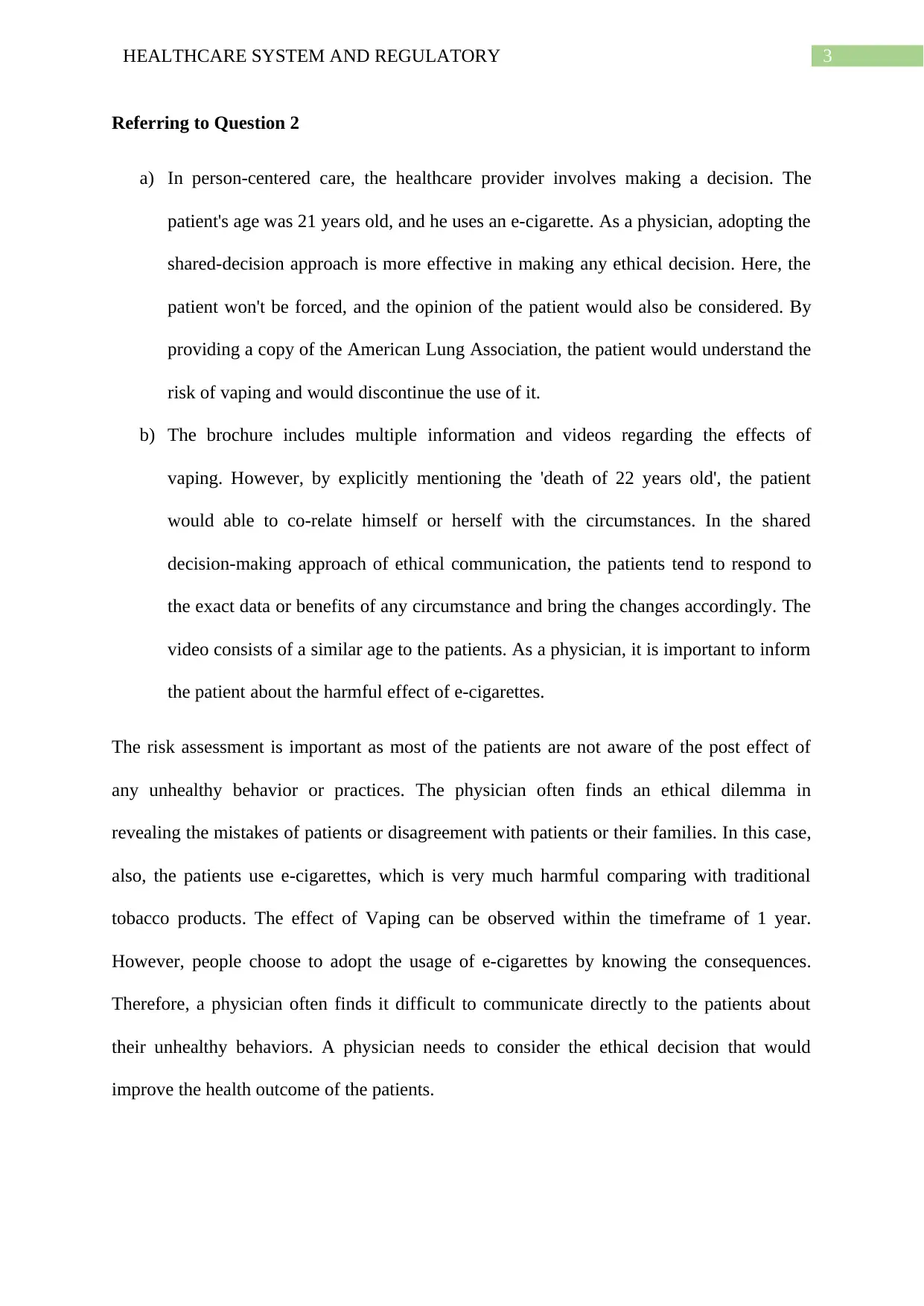
3HEALTHCARE SYSTEM AND REGULATORY
Referring to Question 2
a) In person-centered care, the healthcare provider involves making a decision. The
patient's age was 21 years old, and he uses an e-cigarette. As a physician, adopting the
shared-decision approach is more effective in making any ethical decision. Here, the
patient won't be forced, and the opinion of the patient would also be considered. By
providing a copy of the American Lung Association, the patient would understand the
risk of vaping and would discontinue the use of it.
b) The brochure includes multiple information and videos regarding the effects of
vaping. However, by explicitly mentioning the 'death of 22 years old', the patient
would able to co-relate himself or herself with the circumstances. In the shared
decision-making approach of ethical communication, the patients tend to respond to
the exact data or benefits of any circumstance and bring the changes accordingly. The
video consists of a similar age to the patients. As a physician, it is important to inform
the patient about the harmful effect of e-cigarettes.
The risk assessment is important as most of the patients are not aware of the post effect of
any unhealthy behavior or practices. The physician often finds an ethical dilemma in
revealing the mistakes of patients or disagreement with patients or their families. In this case,
also, the patients use e-cigarettes, which is very much harmful comparing with traditional
tobacco products. The effect of Vaping can be observed within the timeframe of 1 year.
However, people choose to adopt the usage of e-cigarettes by knowing the consequences.
Therefore, a physician often finds it difficult to communicate directly to the patients about
their unhealthy behaviors. A physician needs to consider the ethical decision that would
improve the health outcome of the patients.
Referring to Question 2
a) In person-centered care, the healthcare provider involves making a decision. The
patient's age was 21 years old, and he uses an e-cigarette. As a physician, adopting the
shared-decision approach is more effective in making any ethical decision. Here, the
patient won't be forced, and the opinion of the patient would also be considered. By
providing a copy of the American Lung Association, the patient would understand the
risk of vaping and would discontinue the use of it.
b) The brochure includes multiple information and videos regarding the effects of
vaping. However, by explicitly mentioning the 'death of 22 years old', the patient
would able to co-relate himself or herself with the circumstances. In the shared
decision-making approach of ethical communication, the patients tend to respond to
the exact data or benefits of any circumstance and bring the changes accordingly. The
video consists of a similar age to the patients. As a physician, it is important to inform
the patient about the harmful effect of e-cigarettes.
The risk assessment is important as most of the patients are not aware of the post effect of
any unhealthy behavior or practices. The physician often finds an ethical dilemma in
revealing the mistakes of patients or disagreement with patients or their families. In this case,
also, the patients use e-cigarettes, which is very much harmful comparing with traditional
tobacco products. The effect of Vaping can be observed within the timeframe of 1 year.
However, people choose to adopt the usage of e-cigarettes by knowing the consequences.
Therefore, a physician often finds it difficult to communicate directly to the patients about
their unhealthy behaviors. A physician needs to consider the ethical decision that would
improve the health outcome of the patients.
Secure Best Marks with AI Grader
Need help grading? Try our AI Grader for instant feedback on your assignments.
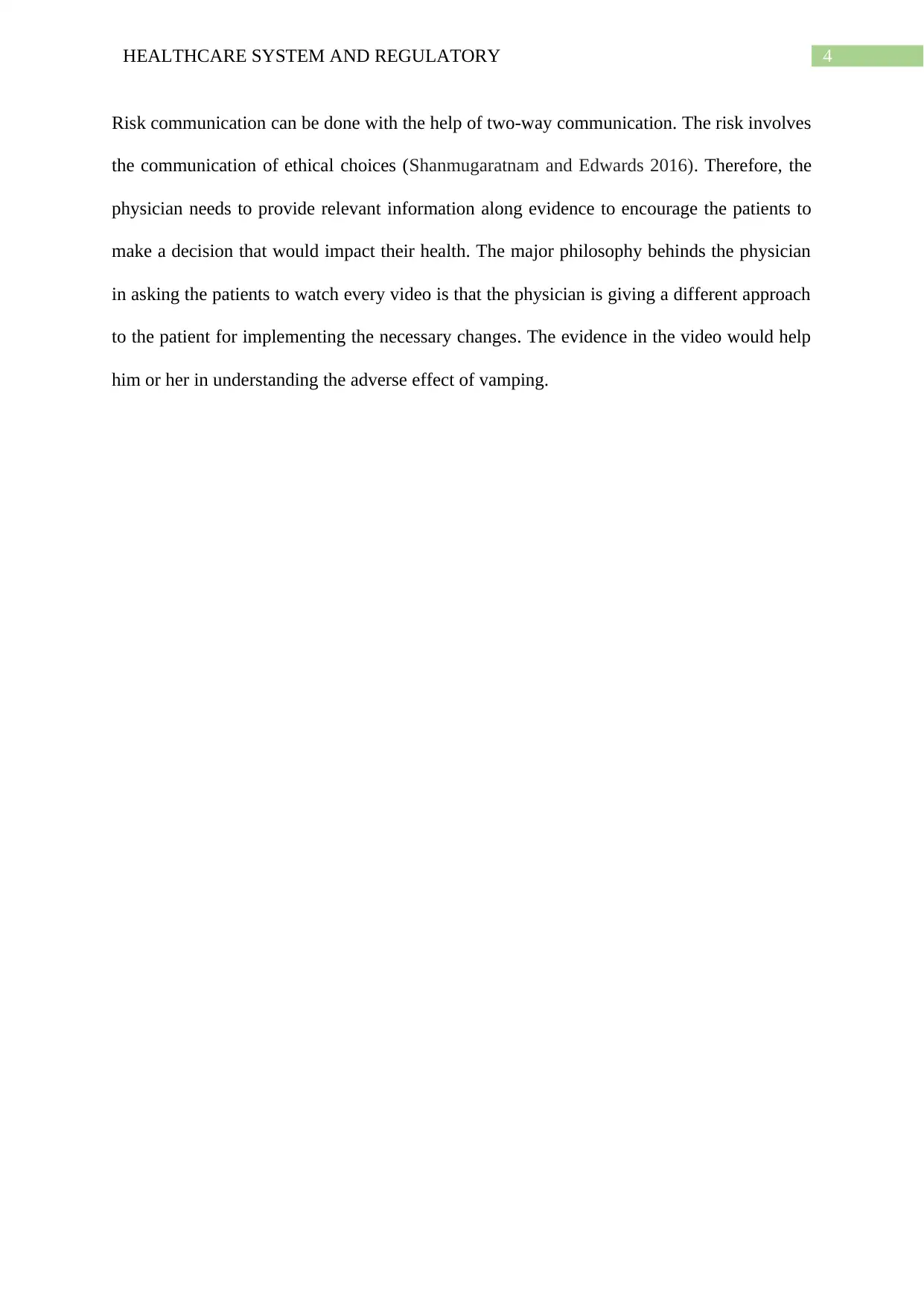
4HEALTHCARE SYSTEM AND REGULATORY
Risk communication can be done with the help of two-way communication. The risk involves
the communication of ethical choices (Shanmugaratnam and Edwards 2016). Therefore, the
physician needs to provide relevant information along evidence to encourage the patients to
make a decision that would impact their health. The major philosophy behinds the physician
in asking the patients to watch every video is that the physician is giving a different approach
to the patient for implementing the necessary changes. The evidence in the video would help
him or her in understanding the adverse effect of vamping.
Risk communication can be done with the help of two-way communication. The risk involves
the communication of ethical choices (Shanmugaratnam and Edwards 2016). Therefore, the
physician needs to provide relevant information along evidence to encourage the patients to
make a decision that would impact their health. The major philosophy behinds the physician
in asking the patients to watch every video is that the physician is giving a different approach
to the patient for implementing the necessary changes. The evidence in the video would help
him or her in understanding the adverse effect of vamping.
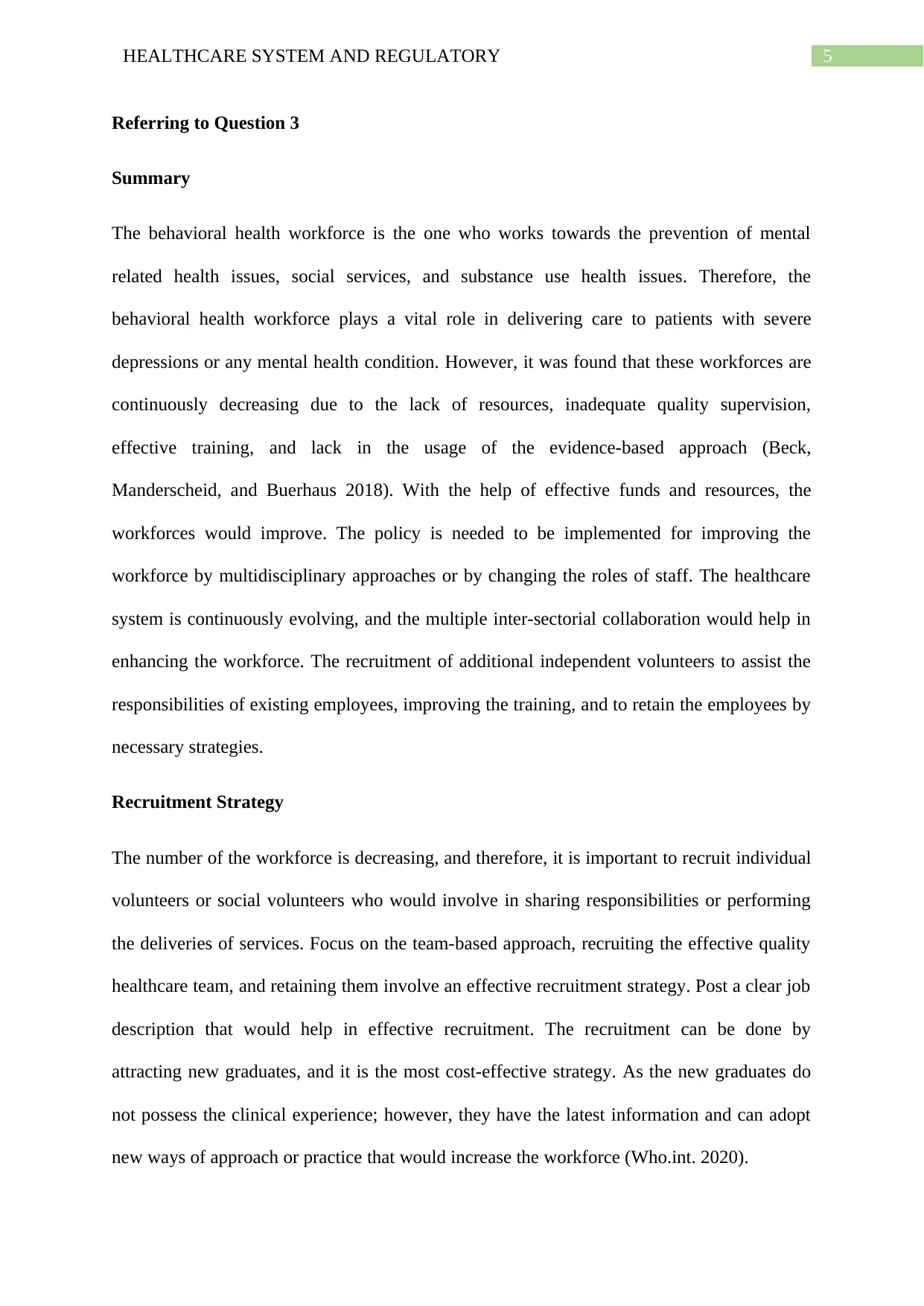
5HEALTHCARE SYSTEM AND REGULATORY
Referring to Question 3
Summary
The behavioral health workforce is the one who works towards the prevention of mental
related health issues, social services, and substance use health issues. Therefore, the
behavioral health workforce plays a vital role in delivering care to patients with severe
depressions or any mental health condition. However, it was found that these workforces are
continuously decreasing due to the lack of resources, inadequate quality supervision,
effective training, and lack in the usage of the evidence-based approach (Beck,
Manderscheid, and Buerhaus 2018). With the help of effective funds and resources, the
workforces would improve. The policy is needed to be implemented for improving the
workforce by multidisciplinary approaches or by changing the roles of staff. The healthcare
system is continuously evolving, and the multiple inter-sectorial collaboration would help in
enhancing the workforce. The recruitment of additional independent volunteers to assist the
responsibilities of existing employees, improving the training, and to retain the employees by
necessary strategies.
Recruitment Strategy
The number of the workforce is decreasing, and therefore, it is important to recruit individual
volunteers or social volunteers who would involve in sharing responsibilities or performing
the deliveries of services. Focus on the team-based approach, recruiting the effective quality
healthcare team, and retaining them involve an effective recruitment strategy. Post a clear job
description that would help in effective recruitment. The recruitment can be done by
attracting new graduates, and it is the most cost-effective strategy. As the new graduates do
not possess the clinical experience; however, they have the latest information and can adopt
new ways of approach or practice that would increase the workforce (Who.int. 2020).
Referring to Question 3
Summary
The behavioral health workforce is the one who works towards the prevention of mental
related health issues, social services, and substance use health issues. Therefore, the
behavioral health workforce plays a vital role in delivering care to patients with severe
depressions or any mental health condition. However, it was found that these workforces are
continuously decreasing due to the lack of resources, inadequate quality supervision,
effective training, and lack in the usage of the evidence-based approach (Beck,
Manderscheid, and Buerhaus 2018). With the help of effective funds and resources, the
workforces would improve. The policy is needed to be implemented for improving the
workforce by multidisciplinary approaches or by changing the roles of staff. The healthcare
system is continuously evolving, and the multiple inter-sectorial collaboration would help in
enhancing the workforce. The recruitment of additional independent volunteers to assist the
responsibilities of existing employees, improving the training, and to retain the employees by
necessary strategies.
Recruitment Strategy
The number of the workforce is decreasing, and therefore, it is important to recruit individual
volunteers or social volunteers who would involve in sharing responsibilities or performing
the deliveries of services. Focus on the team-based approach, recruiting the effective quality
healthcare team, and retaining them involve an effective recruitment strategy. Post a clear job
description that would help in effective recruitment. The recruitment can be done by
attracting new graduates, and it is the most cost-effective strategy. As the new graduates do
not possess the clinical experience; however, they have the latest information and can adopt
new ways of approach or practice that would increase the workforce (Who.int. 2020).
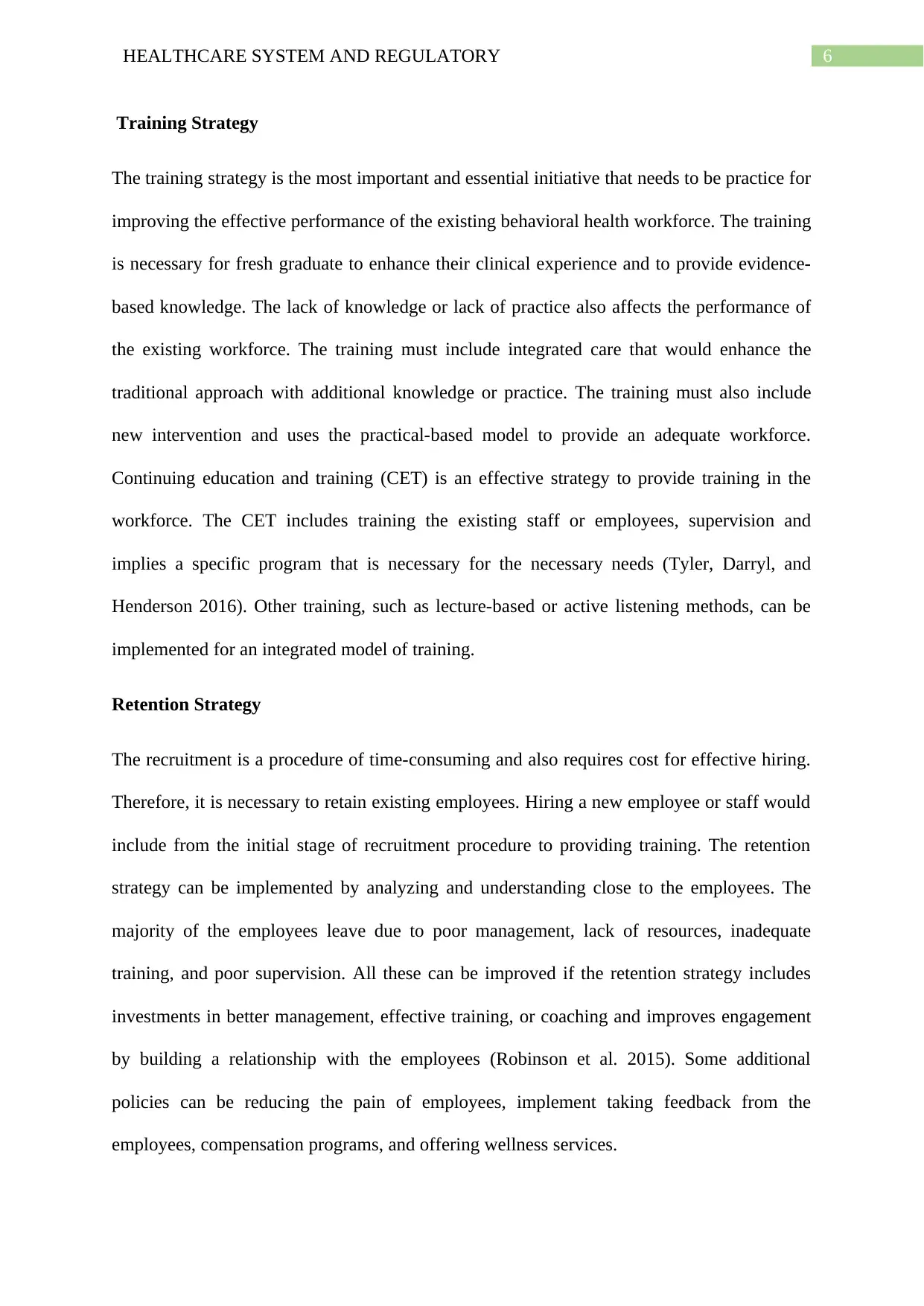
6HEALTHCARE SYSTEM AND REGULATORY
Training Strategy
The training strategy is the most important and essential initiative that needs to be practice for
improving the effective performance of the existing behavioral health workforce. The training
is necessary for fresh graduate to enhance their clinical experience and to provide evidence-
based knowledge. The lack of knowledge or lack of practice also affects the performance of
the existing workforce. The training must include integrated care that would enhance the
traditional approach with additional knowledge or practice. The training must also include
new intervention and uses the practical-based model to provide an adequate workforce.
Continuing education and training (CET) is an effective strategy to provide training in the
workforce. The CET includes training the existing staff or employees, supervision and
implies a specific program that is necessary for the necessary needs (Tyler, Darryl, and
Henderson 2016). Other training, such as lecture-based or active listening methods, can be
implemented for an integrated model of training.
Retention Strategy
The recruitment is a procedure of time-consuming and also requires cost for effective hiring.
Therefore, it is necessary to retain existing employees. Hiring a new employee or staff would
include from the initial stage of recruitment procedure to providing training. The retention
strategy can be implemented by analyzing and understanding close to the employees. The
majority of the employees leave due to poor management, lack of resources, inadequate
training, and poor supervision. All these can be improved if the retention strategy includes
investments in better management, effective training, or coaching and improves engagement
by building a relationship with the employees (Robinson et al. 2015). Some additional
policies can be reducing the pain of employees, implement taking feedback from the
employees, compensation programs, and offering wellness services.
Training Strategy
The training strategy is the most important and essential initiative that needs to be practice for
improving the effective performance of the existing behavioral health workforce. The training
is necessary for fresh graduate to enhance their clinical experience and to provide evidence-
based knowledge. The lack of knowledge or lack of practice also affects the performance of
the existing workforce. The training must include integrated care that would enhance the
traditional approach with additional knowledge or practice. The training must also include
new intervention and uses the practical-based model to provide an adequate workforce.
Continuing education and training (CET) is an effective strategy to provide training in the
workforce. The CET includes training the existing staff or employees, supervision and
implies a specific program that is necessary for the necessary needs (Tyler, Darryl, and
Henderson 2016). Other training, such as lecture-based or active listening methods, can be
implemented for an integrated model of training.
Retention Strategy
The recruitment is a procedure of time-consuming and also requires cost for effective hiring.
Therefore, it is necessary to retain existing employees. Hiring a new employee or staff would
include from the initial stage of recruitment procedure to providing training. The retention
strategy can be implemented by analyzing and understanding close to the employees. The
majority of the employees leave due to poor management, lack of resources, inadequate
training, and poor supervision. All these can be improved if the retention strategy includes
investments in better management, effective training, or coaching and improves engagement
by building a relationship with the employees (Robinson et al. 2015). Some additional
policies can be reducing the pain of employees, implement taking feedback from the
employees, compensation programs, and offering wellness services.
Paraphrase This Document
Need a fresh take? Get an instant paraphrase of this document with our AI Paraphraser
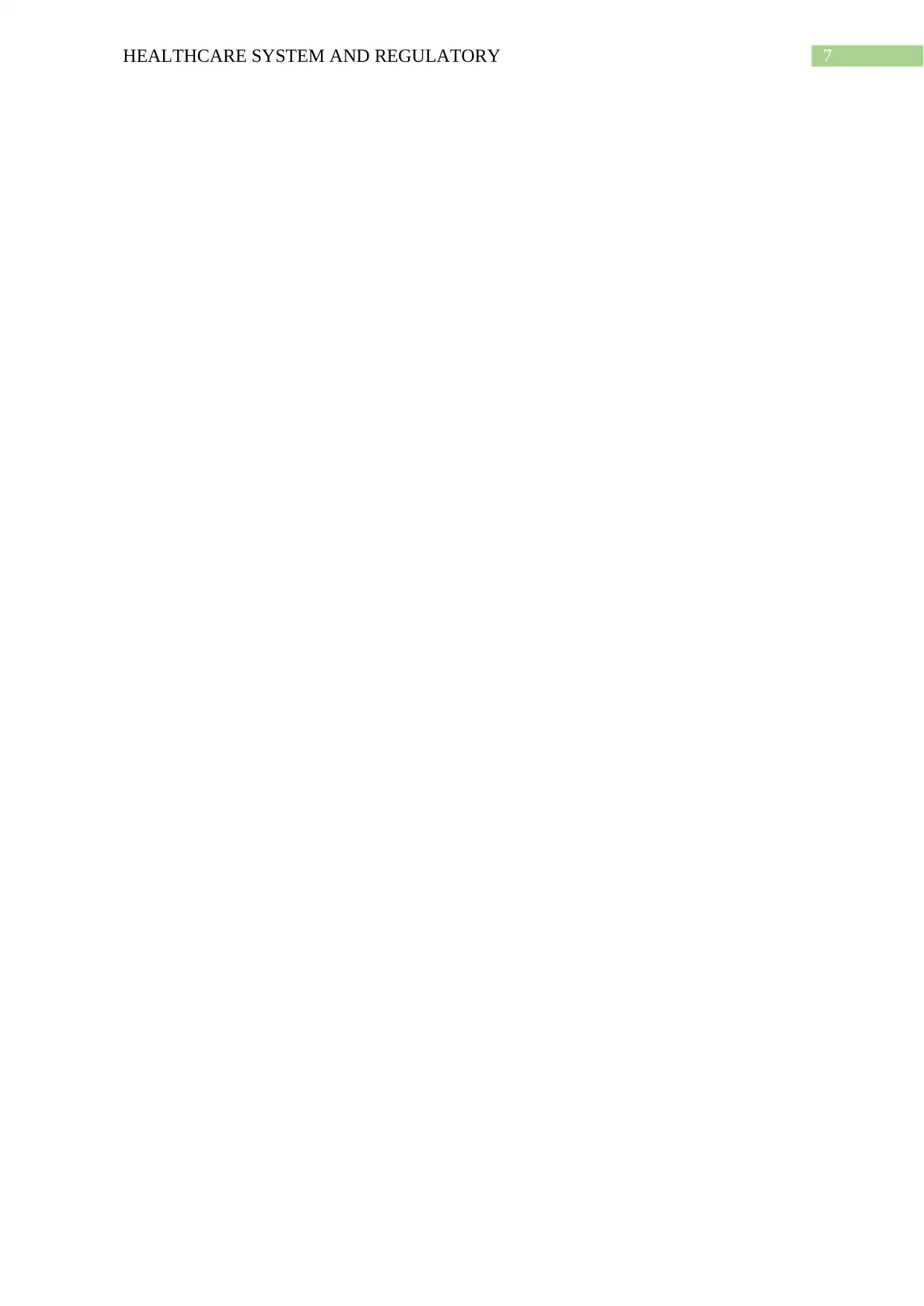
7HEALTHCARE SYSTEM AND REGULATORY
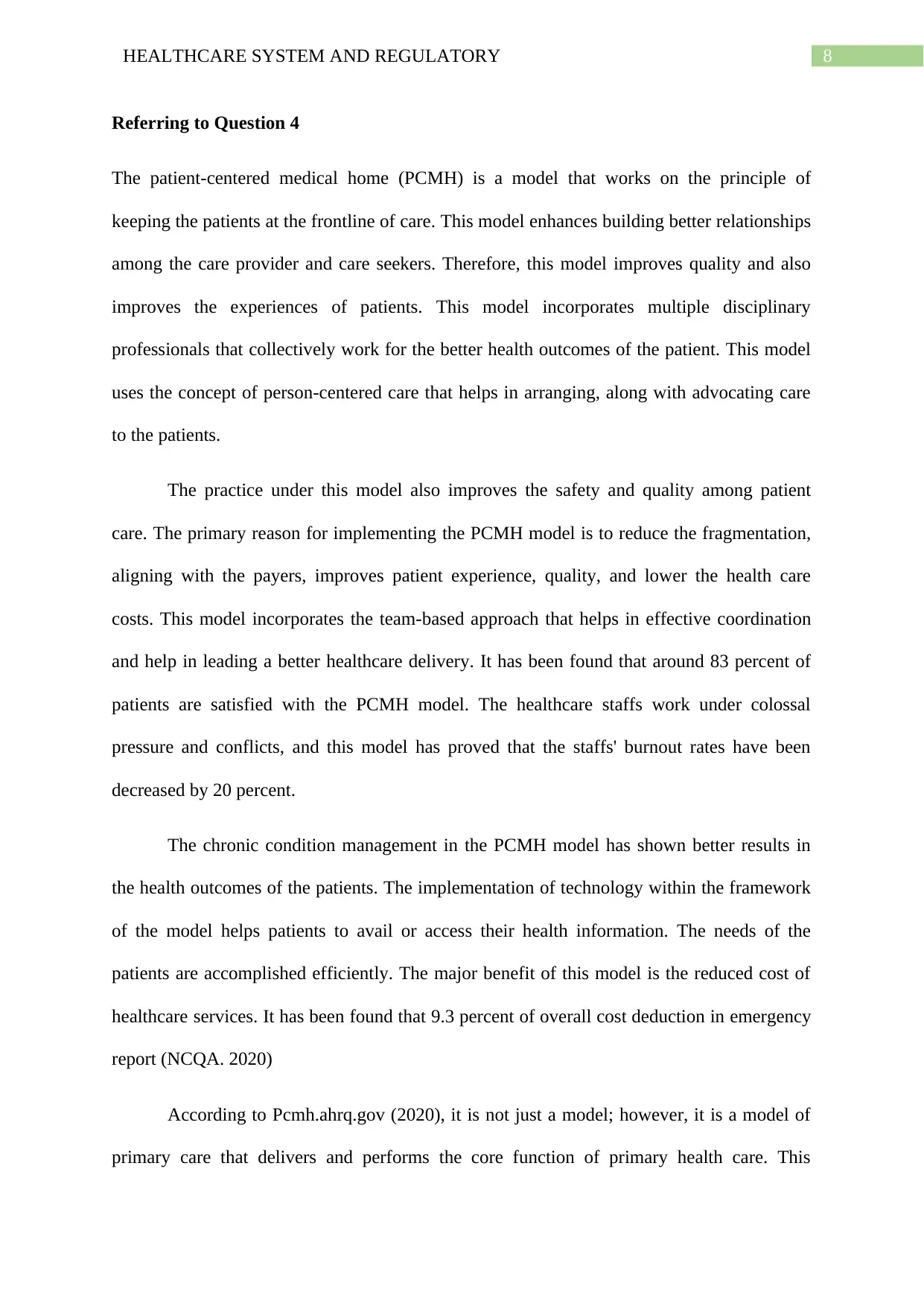
8HEALTHCARE SYSTEM AND REGULATORY
Referring to Question 4
The patient-centered medical home (PCMH) is a model that works on the principle of
keeping the patients at the frontline of care. This model enhances building better relationships
among the care provider and care seekers. Therefore, this model improves quality and also
improves the experiences of patients. This model incorporates multiple disciplinary
professionals that collectively work for the better health outcomes of the patient. This model
uses the concept of person-centered care that helps in arranging, along with advocating care
to the patients.
The practice under this model also improves the safety and quality among patient
care. The primary reason for implementing the PCMH model is to reduce the fragmentation,
aligning with the payers, improves patient experience, quality, and lower the health care
costs. This model incorporates the team-based approach that helps in effective coordination
and help in leading a better healthcare delivery. It has been found that around 83 percent of
patients are satisfied with the PCMH model. The healthcare staffs work under colossal
pressure and conflicts, and this model has proved that the staffs' burnout rates have been
decreased by 20 percent.
The chronic condition management in the PCMH model has shown better results in
the health outcomes of the patients. The implementation of technology within the framework
of the model helps patients to avail or access their health information. The needs of the
patients are accomplished efficiently. The major benefit of this model is the reduced cost of
healthcare services. It has been found that 9.3 percent of overall cost deduction in emergency
report (NCQA. 2020)
According to Pcmh.ahrq.gov (2020), it is not just a model; however, it is a model of
primary care that delivers and performs the core function of primary health care. This
Referring to Question 4
The patient-centered medical home (PCMH) is a model that works on the principle of
keeping the patients at the frontline of care. This model enhances building better relationships
among the care provider and care seekers. Therefore, this model improves quality and also
improves the experiences of patients. This model incorporates multiple disciplinary
professionals that collectively work for the better health outcomes of the patient. This model
uses the concept of person-centered care that helps in arranging, along with advocating care
to the patients.
The practice under this model also improves the safety and quality among patient
care. The primary reason for implementing the PCMH model is to reduce the fragmentation,
aligning with the payers, improves patient experience, quality, and lower the health care
costs. This model incorporates the team-based approach that helps in effective coordination
and help in leading a better healthcare delivery. It has been found that around 83 percent of
patients are satisfied with the PCMH model. The healthcare staffs work under colossal
pressure and conflicts, and this model has proved that the staffs' burnout rates have been
decreased by 20 percent.
The chronic condition management in the PCMH model has shown better results in
the health outcomes of the patients. The implementation of technology within the framework
of the model helps patients to avail or access their health information. The needs of the
patients are accomplished efficiently. The major benefit of this model is the reduced cost of
healthcare services. It has been found that 9.3 percent of overall cost deduction in emergency
report (NCQA. 2020)
According to Pcmh.ahrq.gov (2020), it is not just a model; however, it is a model of
primary care that delivers and performs the core function of primary health care. This

9HEALTHCARE SYSTEM AND REGULATORY
medical home five attributes: comprehensive care, patient-centered, coordinated care,
accessible services, and quality, along with safety. The first attribute is comprehensive care,
where it includes the needs of the patients. The team-based approach, including a physician,
nurses, pharmacists, and other healthcare professions, would work to deliver the needs of the
patients. Patient-centered care would help in building a relationship with the patients for
effective health outcomes. Coordinated care includes specialty care, home care, and any other
community services for improving and enhancing the team-based approach. The accessible
service works in reducing the wait time of the patients, and usage of electronic means for
effective communication among healthcare providers and healthcare seekers.
The final attributes are quality and safety, which is the most important aspects, the
model would use and implement the evidence-based approach or medicine or any techniques
for reducing the errors and improving the safety of the patients.
medical home five attributes: comprehensive care, patient-centered, coordinated care,
accessible services, and quality, along with safety. The first attribute is comprehensive care,
where it includes the needs of the patients. The team-based approach, including a physician,
nurses, pharmacists, and other healthcare professions, would work to deliver the needs of the
patients. Patient-centered care would help in building a relationship with the patients for
effective health outcomes. Coordinated care includes specialty care, home care, and any other
community services for improving and enhancing the team-based approach. The accessible
service works in reducing the wait time of the patients, and usage of electronic means for
effective communication among healthcare providers and healthcare seekers.
The final attributes are quality and safety, which is the most important aspects, the
model would use and implement the evidence-based approach or medicine or any techniques
for reducing the errors and improving the safety of the patients.
Secure Best Marks with AI Grader
Need help grading? Try our AI Grader for instant feedback on your assignments.

10HEALTHCARE SYSTEM AND REGULATORY
Referring to Question 5
The highly regulatory agencies that have been considered here are Centers for Medicare and
Medicaid Services (CMS), National Institutes of Health (NIH), Department of health and
services (HHS), Centers for Disease Control and Prevention (CDC), and Food and Drug
Administration (FDA).
CMS comes under the department of health and human services. This service
provides efficient brand experiences to consumers. They offer multiple health insurance
programs to the people. It is a federal agency that works in improving the health system by
providing effective programs such as Medicare and Medicaid. Therefore, this agency leads to
a better healthcare system by providing access to coverage (Cms.gov 2020).
NIH also works under or is a part of the Department of Health and Human Services.
This agency focuses on medical research. They discover new methods and techniques in
improving the health and health systems. Their primary role is in saving lives by improving
the diagnoses. In recent years, this agency has accomplished a huge fall in the deaths dues to
cancers. Their major mission is to enhance lives and strengthen the health system by reducing
the illness and disability among the people (National Institutes of Health 2020).
The mission of HHS is to protect the health and wellbeing of every individual living
in America. They bring useful advances in technologies and treatments for improving the
overall health outcomes of the people. There are multiple agencies such as administration for
children and families (ACF), Administration for Community Living (ACL), and many others
that focus on the welfare of the people by improving the overall health system (HHS.gov.
2020).
CDC is a major operating component of HHS. This agency works 24 hours in
providing effective care to the patients. Their major responsibility is to provide health and
Referring to Question 5
The highly regulatory agencies that have been considered here are Centers for Medicare and
Medicaid Services (CMS), National Institutes of Health (NIH), Department of health and
services (HHS), Centers for Disease Control and Prevention (CDC), and Food and Drug
Administration (FDA).
CMS comes under the department of health and human services. This service
provides efficient brand experiences to consumers. They offer multiple health insurance
programs to the people. It is a federal agency that works in improving the health system by
providing effective programs such as Medicare and Medicaid. Therefore, this agency leads to
a better healthcare system by providing access to coverage (Cms.gov 2020).
NIH also works under or is a part of the Department of Health and Human Services.
This agency focuses on medical research. They discover new methods and techniques in
improving the health and health systems. Their primary role is in saving lives by improving
the diagnoses. In recent years, this agency has accomplished a huge fall in the deaths dues to
cancers. Their major mission is to enhance lives and strengthen the health system by reducing
the illness and disability among the people (National Institutes of Health 2020).
The mission of HHS is to protect the health and wellbeing of every individual living
in America. They bring useful advances in technologies and treatments for improving the
overall health outcomes of the people. There are multiple agencies such as administration for
children and families (ACF), Administration for Community Living (ACL), and many others
that focus on the welfare of the people by improving the overall health system (HHS.gov.
2020).
CDC is a major operating component of HHS. This agency works 24 hours in
providing effective care to the patients. Their major responsibility is to provide health and
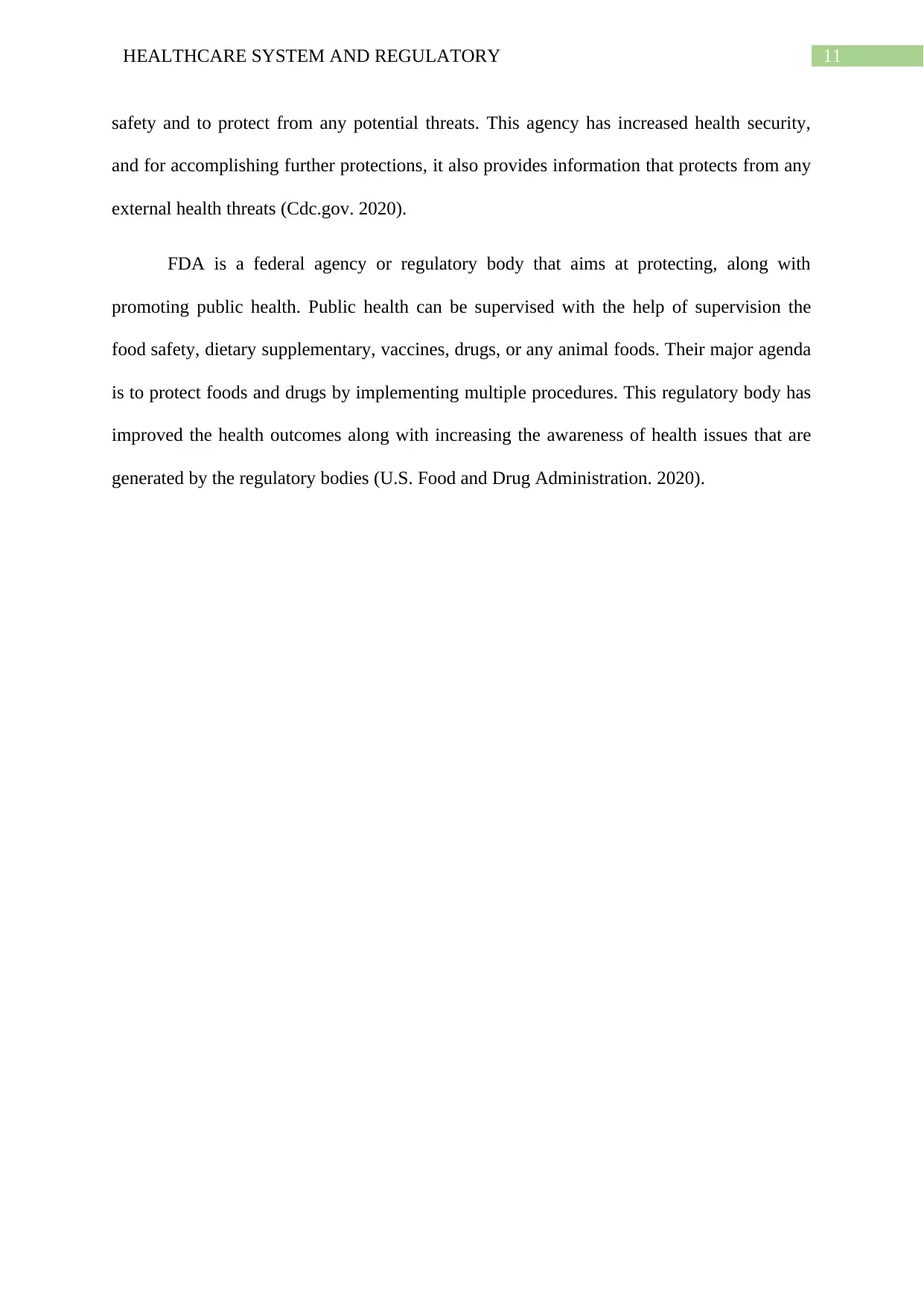
11HEALTHCARE SYSTEM AND REGULATORY
safety and to protect from any potential threats. This agency has increased health security,
and for accomplishing further protections, it also provides information that protects from any
external health threats (Cdc.gov. 2020).
FDA is a federal agency or regulatory body that aims at protecting, along with
promoting public health. Public health can be supervised with the help of supervision the
food safety, dietary supplementary, vaccines, drugs, or any animal foods. Their major agenda
is to protect foods and drugs by implementing multiple procedures. This regulatory body has
improved the health outcomes along with increasing the awareness of health issues that are
generated by the regulatory bodies (U.S. Food and Drug Administration. 2020).
safety and to protect from any potential threats. This agency has increased health security,
and for accomplishing further protections, it also provides information that protects from any
external health threats (Cdc.gov. 2020).
FDA is a federal agency or regulatory body that aims at protecting, along with
promoting public health. Public health can be supervised with the help of supervision the
food safety, dietary supplementary, vaccines, drugs, or any animal foods. Their major agenda
is to protect foods and drugs by implementing multiple procedures. This regulatory body has
improved the health outcomes along with increasing the awareness of health issues that are
generated by the regulatory bodies (U.S. Food and Drug Administration. 2020).
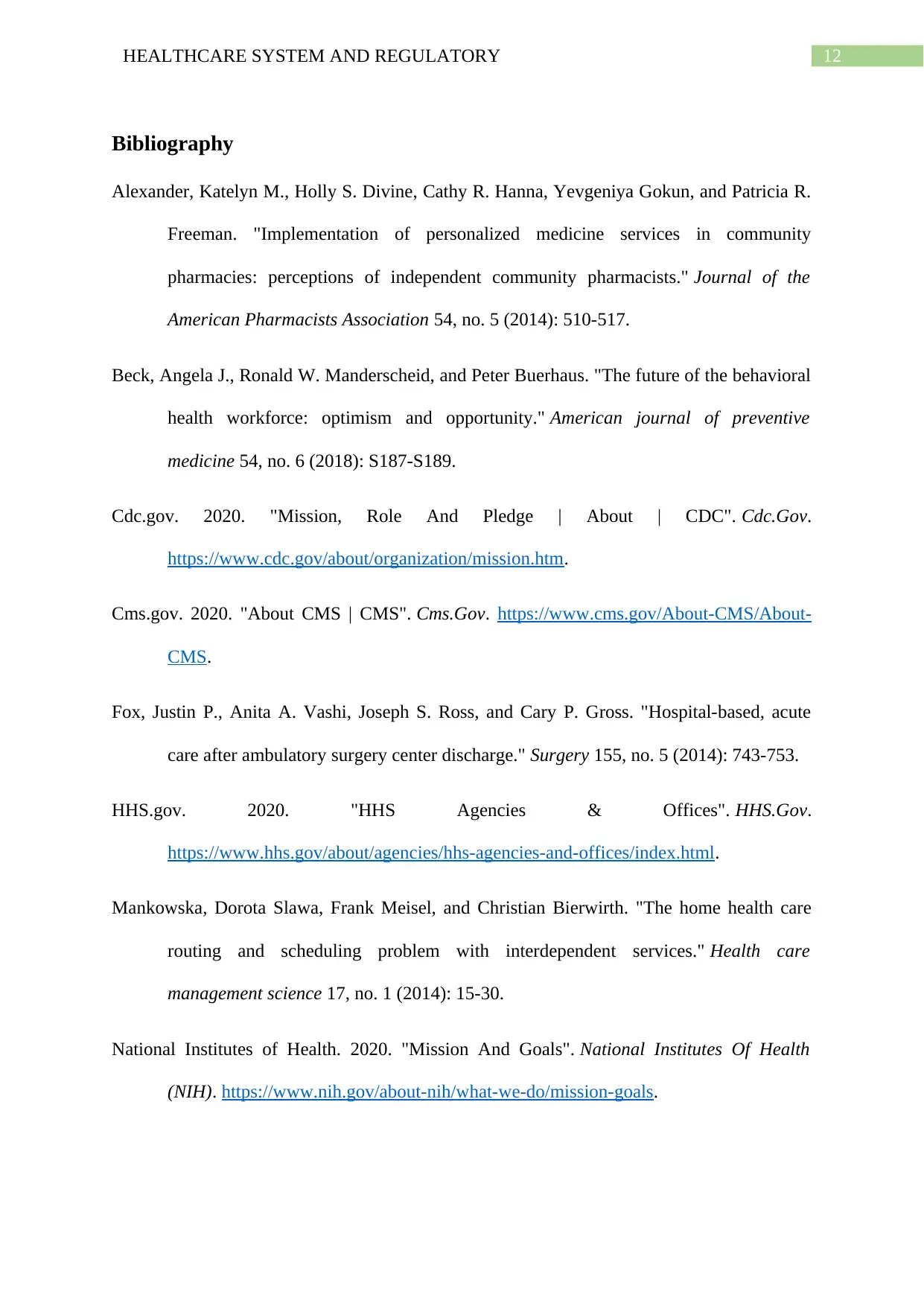
12HEALTHCARE SYSTEM AND REGULATORY
Bibliography
Alexander, Katelyn M., Holly S. Divine, Cathy R. Hanna, Yevgeniya Gokun, and Patricia R.
Freeman. "Implementation of personalized medicine services in community
pharmacies: perceptions of independent community pharmacists." Journal of the
American Pharmacists Association 54, no. 5 (2014): 510-517.
Beck, Angela J., Ronald W. Manderscheid, and Peter Buerhaus. "The future of the behavioral
health workforce: optimism and opportunity." American journal of preventive
medicine 54, no. 6 (2018): S187-S189.
Cdc.gov. 2020. "Mission, Role And Pledge | About | CDC". Cdc.Gov.
https://www.cdc.gov/about/organization/mission.htm.
Cms.gov. 2020. "About CMS | CMS". Cms.Gov. https://www.cms.gov/About-CMS/About-
CMS.
Fox, Justin P., Anita A. Vashi, Joseph S. Ross, and Cary P. Gross. "Hospital-based, acute
care after ambulatory surgery center discharge." Surgery 155, no. 5 (2014): 743-753.
HHS.gov. 2020. "HHS Agencies & Offices". HHS.Gov.
https://www.hhs.gov/about/agencies/hhs-agencies-and-offices/index.html.
Mankowska, Dorota Slawa, Frank Meisel, and Christian Bierwirth. "The home health care
routing and scheduling problem with interdependent services." Health care
management science 17, no. 1 (2014): 15-30.
National Institutes of Health. 2020. "Mission And Goals". National Institutes Of Health
(NIH). https://www.nih.gov/about-nih/what-we-do/mission-goals.
Bibliography
Alexander, Katelyn M., Holly S. Divine, Cathy R. Hanna, Yevgeniya Gokun, and Patricia R.
Freeman. "Implementation of personalized medicine services in community
pharmacies: perceptions of independent community pharmacists." Journal of the
American Pharmacists Association 54, no. 5 (2014): 510-517.
Beck, Angela J., Ronald W. Manderscheid, and Peter Buerhaus. "The future of the behavioral
health workforce: optimism and opportunity." American journal of preventive
medicine 54, no. 6 (2018): S187-S189.
Cdc.gov. 2020. "Mission, Role And Pledge | About | CDC". Cdc.Gov.
https://www.cdc.gov/about/organization/mission.htm.
Cms.gov. 2020. "About CMS | CMS". Cms.Gov. https://www.cms.gov/About-CMS/About-
CMS.
Fox, Justin P., Anita A. Vashi, Joseph S. Ross, and Cary P. Gross. "Hospital-based, acute
care after ambulatory surgery center discharge." Surgery 155, no. 5 (2014): 743-753.
HHS.gov. 2020. "HHS Agencies & Offices". HHS.Gov.
https://www.hhs.gov/about/agencies/hhs-agencies-and-offices/index.html.
Mankowska, Dorota Slawa, Frank Meisel, and Christian Bierwirth. "The home health care
routing and scheduling problem with interdependent services." Health care
management science 17, no. 1 (2014): 15-30.
National Institutes of Health. 2020. "Mission And Goals". National Institutes Of Health
(NIH). https://www.nih.gov/about-nih/what-we-do/mission-goals.
Paraphrase This Document
Need a fresh take? Get an instant paraphrase of this document with our AI Paraphraser
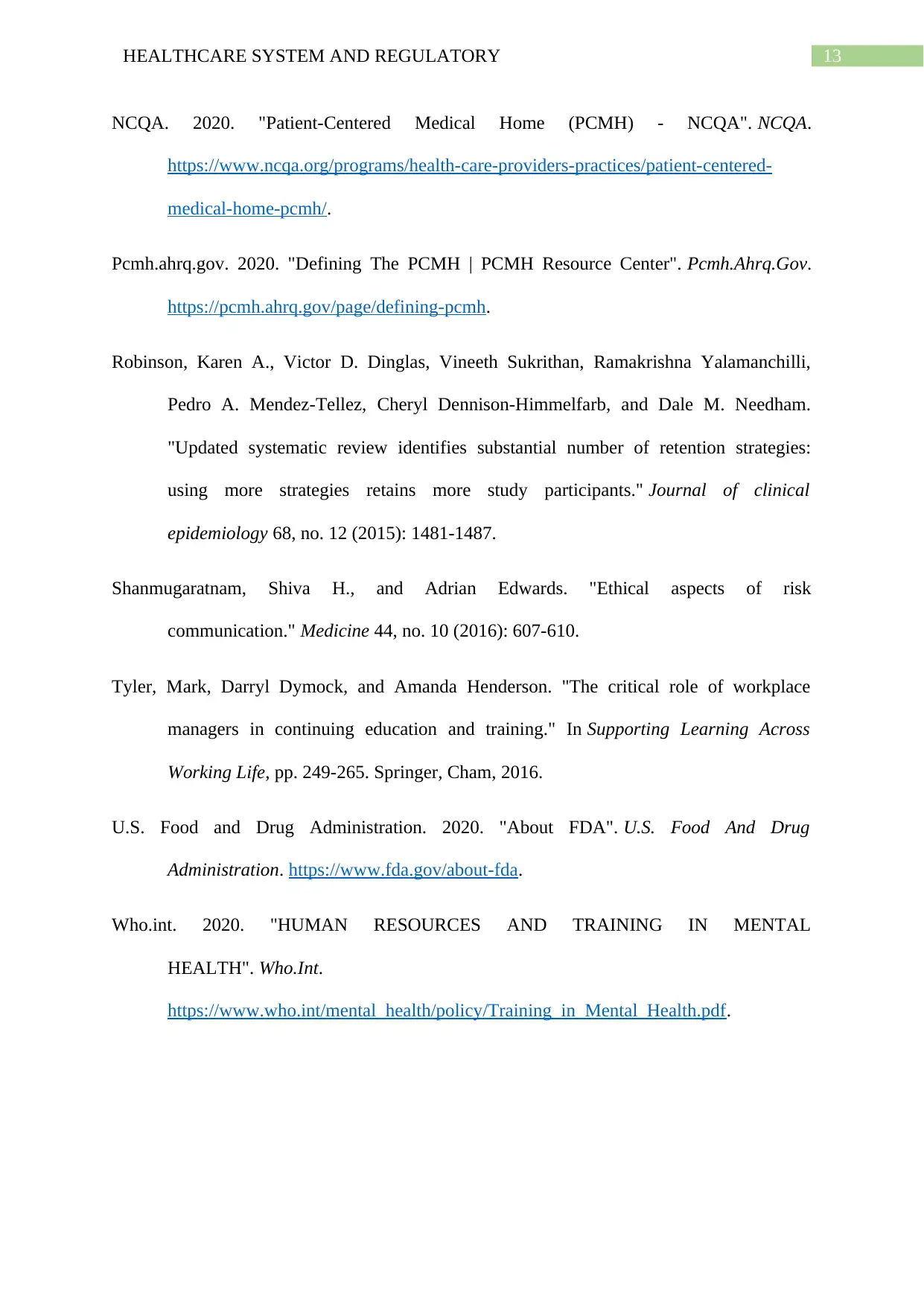
13HEALTHCARE SYSTEM AND REGULATORY
NCQA. 2020. "Patient-Centered Medical Home (PCMH) - NCQA". NCQA.
https://www.ncqa.org/programs/health-care-providers-practices/patient-centered-
medical-home-pcmh/.
Pcmh.ahrq.gov. 2020. "Defining The PCMH | PCMH Resource Center". Pcmh.Ahrq.Gov.
https://pcmh.ahrq.gov/page/defining-pcmh.
Robinson, Karen A., Victor D. Dinglas, Vineeth Sukrithan, Ramakrishna Yalamanchilli,
Pedro A. Mendez-Tellez, Cheryl Dennison-Himmelfarb, and Dale M. Needham.
"Updated systematic review identifies substantial number of retention strategies:
using more strategies retains more study participants." Journal of clinical
epidemiology 68, no. 12 (2015): 1481-1487.
Shanmugaratnam, Shiva H., and Adrian Edwards. "Ethical aspects of risk
communication." Medicine 44, no. 10 (2016): 607-610.
Tyler, Mark, Darryl Dymock, and Amanda Henderson. "The critical role of workplace
managers in continuing education and training." In Supporting Learning Across
Working Life, pp. 249-265. Springer, Cham, 2016.
U.S. Food and Drug Administration. 2020. "About FDA". U.S. Food And Drug
Administration. https://www.fda.gov/about-fda.
Who.int. 2020. "HUMAN RESOURCES AND TRAINING IN MENTAL
HEALTH". Who.Int.
https://www.who.int/mental_health/policy/Training_in_Mental_Health.pdf.
NCQA. 2020. "Patient-Centered Medical Home (PCMH) - NCQA". NCQA.
https://www.ncqa.org/programs/health-care-providers-practices/patient-centered-
medical-home-pcmh/.
Pcmh.ahrq.gov. 2020. "Defining The PCMH | PCMH Resource Center". Pcmh.Ahrq.Gov.
https://pcmh.ahrq.gov/page/defining-pcmh.
Robinson, Karen A., Victor D. Dinglas, Vineeth Sukrithan, Ramakrishna Yalamanchilli,
Pedro A. Mendez-Tellez, Cheryl Dennison-Himmelfarb, and Dale M. Needham.
"Updated systematic review identifies substantial number of retention strategies:
using more strategies retains more study participants." Journal of clinical
epidemiology 68, no. 12 (2015): 1481-1487.
Shanmugaratnam, Shiva H., and Adrian Edwards. "Ethical aspects of risk
communication." Medicine 44, no. 10 (2016): 607-610.
Tyler, Mark, Darryl Dymock, and Amanda Henderson. "The critical role of workplace
managers in continuing education and training." In Supporting Learning Across
Working Life, pp. 249-265. Springer, Cham, 2016.
U.S. Food and Drug Administration. 2020. "About FDA". U.S. Food And Drug
Administration. https://www.fda.gov/about-fda.
Who.int. 2020. "HUMAN RESOURCES AND TRAINING IN MENTAL
HEALTH". Who.Int.
https://www.who.int/mental_health/policy/Training_in_Mental_Health.pdf.
1 out of 14
Related Documents
Your All-in-One AI-Powered Toolkit for Academic Success.
+13062052269
info@desklib.com
Available 24*7 on WhatsApp / Email
![[object Object]](/_next/static/media/star-bottom.7253800d.svg)
Unlock your academic potential
© 2024 | Zucol Services PVT LTD | All rights reserved.





